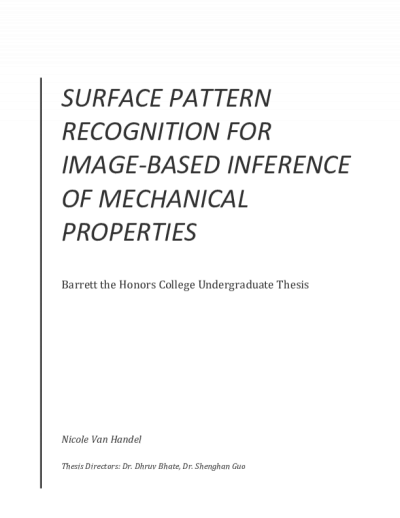Barrett Thesis References.pdf
- Author (aut): Naguib, Sameer
- Thesis director: Bhate, Dhruv
- Committee member: Dahm, Werner
- Contributor (ctb): Barrett, The Honors College
- Contributor (ctb): Mechanical and Aerospace Engineering Program







Due to the vast increase in processing power and energy usage in computing, a need for greater heat dissipation is prevalent. With numerous applications demanding cheaper and more efficient options for thermal management, new technology must be employed. Through the use of additive manufacturing, designs and structures can be created that were not physically possible before without extensive costs. The goal is to design a system that utilizes capillary action, which is the ability for liquids to flow through narrow spaces unassisted. The level of detail required may be achieved with direct metal laser sintering (DMLS) and stereolithography (SLA) 3D printing.

While many 3D printed structures are rigid and stationary, the potential for complex geometries offers a chance for creative and useful motion. Printing structures larger than the print bed, reducing the need for support materials, maintaining multiple states without actuation, and mimicking origami folding are some of the opportunities offered by 3D printed hinges. Current efforts frequently employ advanced materials and equipment that are not available to all users. The purpose of this project was to develop a parametric, print-in-place, self-locking hinge that could be printed using very basic materials and equipment. Six main designs were developed, printed, and tested for their strength in maintaining a locked position. Two general design types were used: 1) sliding hinges and 2) removable pin hinges. The test results were analyzed to identify and explain the causes of observed trends. The amount of interference between the pin vertex and knuckle hole edge was identified as the main factor in hinge strength. After initial testing, the designs were modified and applied to several structures, with successful results for a collapsible hexagon and a folding table. While the initial goal was to have one CAD model as a final product, the need to evaluate tradeoffs depending on the exact application made this impossible. Instead, a set of design guidelines was created to help users make strategic decisions and create their own design. Future work could explore additional scaling effects, printing factors, or other design types.